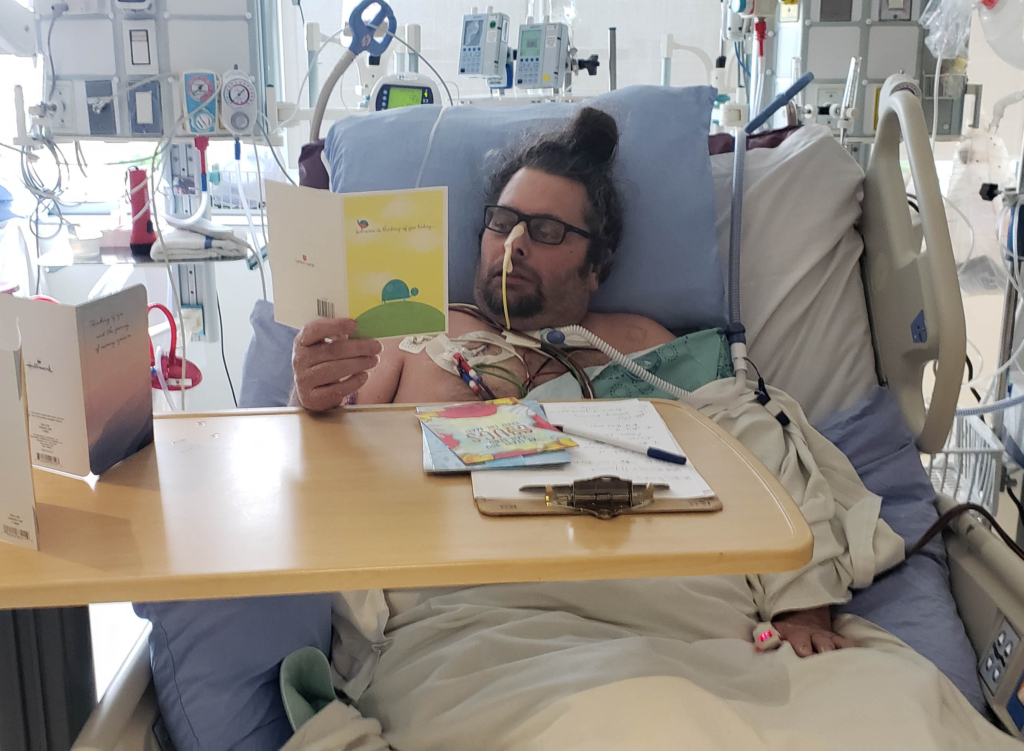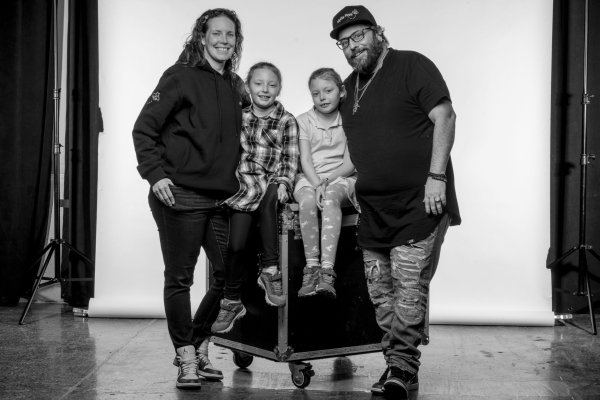Published: June 2024
Sean Sisk has photographed some of the biggest musicians in the world. He was doing just that in July 2023 at Bluesfest when he started to feel off. He developed a fever and was unusually tired. Within days, the popular local photographer was taken to hospital, where he remained for 15 weeks after being diagnosed with invasive group A streptococcal (strep A) disease — and it was ravaging his body.
When asked to recall those days, the 49-year-old needs his wife Erin Fraser’s help, because he has no memory of it. Sean worked the first four days of Bluesfest, but by Sunday, he developed a fever and didn’t go to the show. The fever was quite high, off and on. He slept a lot and tried to stay hydrated despite not having much of an appetite. Sean noticed a bit of redness on one leg, but shrugged it off as a sunburn from the festival.
“But three days after his first symptoms, he developed cramping pain in his lower abdomen and, his hip was hurting. Then, his breathing became laboured, and by the middle of the night, he developed cold sweats,” explains Erin.
In the early morning hours of Thursday, they called an ambulance — a decision that ultimately saved Sean’s life. He was taken to the Montfort Hospital, where he stayed for three weeks before being transferred to The Ottawa Hospital’s General Campus.

What is flesh-eating disease?
Flesh-eating disease is most commonly caused by strep A bacteria, although some other bacteria may cause it as well.
Strep A rapidly attacking Sean’s body
Blood work revealed Sean had developed a severe invasive group A strep infection (iGAS), and he was in septic shock with multiple system organ failure. This infection caused the development of necrotizing fasciitis — also known as flesh-eating disease, and it was attacking his right leg.
Sean was very sick. He was in the ICU, intubated, and on medications to tackle the infection, but his kidneys had shut down. Things became so critical in those early days in hospital that Sean went into cardiac arrest on four different occasions — three of which were in one massive code lasting between 30 and 60 minutes.
Once he was stable enough, he had surgery on his right leg to remove the necrotizing fasciitis. It’s believed the infection entered through a small scratch he had on his right calf, causing the redness that Sean initially thought was a sunburn. A fist-size piece of his thigh was removed, and luckily, his leg was saved. Sean was placed in a medically induced coma to help fight the disease, and his family was left to wonder if the Sean they knew would ever return to them.
"His organs were shutting down because they were overwhelmed with infection. His life was at risk.”
— Dr. Kwadwo Kyeremanteng
“It was a lot of weeks of not knowing what the fallout of that cardiac arrest would be. And it was waiting to see if he would wake up. And if he woke up, what was he going to be like? What kind of physical capacity was he going to be in at that point because there’s a lot of ramifications for being that sick,” says Erin.
During his time in the ICU, Dr. Kwadwo Kyeremanteng, a critical care and palliative care physician at our hospital, was among those who cared for Sean. “He had multi-organ failure, meaning that his organs were shutting down because they were overwhelmed with infection. His life was at risk.”
As Dr. Kyeremanteng explains, strep A is an extremely serious infection that can lead to death. “It is a rapidly progressive rash that develops, and it evolves into the deep layers of the skin. At times, it could require amputation, but because it’s such an aggressive infection, your body’s response to it can be quite toxic. Your blood pressure drops, your ability to get blood flow to your kidneys — to other vital organs, like your liver or intestines, can be compromised.”
Emerging from six weeks in a coma
Despite everything Sean went through, he finally came out of the coma, but it was a slow and gradual process. His body had been through a traumatic experience. “One of my first memories was when my ICU physiotherapist wanted to get me into a wheelchair. I remember that was the absolute last thing I wanted to do. But she just made it as enjoyable as it possibly could have been. She and the team in the ICU — they were just awesome.”
Dr. Kyeremanteng says Sean showed incredible resilience throughout the whole experience — he had a positive mindset and outlook despite everything he had gone through.
“When I think of how grateful Sean was for the care he was receiving and his positive outlook on life moving forward, that makes you appreciate the work that you do,” says Dr. Kyeremanteng. “Sean’s story is like fuel to keep us going. When you’re burned out and tired, a story like Sean’s elevates you.”
As each day passed, Sean showed signs of improvement and was eventually well enough to leave the ICU. He then spent a week in nephrology to monitor his kidney function and to recover before being medically stable enough for rehab. His next big step in recovery was moving to The Ottawa Hospital’s Rehabilitation Centre.
Meet the A-team of Sean's rehab
When Dr. Guy Trudel, a rehabilitation physician and researcher at our hospital, first met Sean at the end of August, he recalls a man who was scared and uncertain as to what his future looked like. He had spent six weeks in a coma.
“Sean was very anxious trying to come to terms with what was happening to him. He had been through a traumatic ordeal, and he was lost. He was uncertain as to what his future would look like,” explains Dr. Trudel.

“We assess every patient individual goals and plan our intervention as a highly collaborative and interdisciplinary team."
— Dr. Guy Trudel
Lucky for Sean, the Rehab Centre is well equipped with a specialized team to help patients just like him — patients who have multiple health issues, both mental and physical. “We assess every patient individual goals and plan our intervention as a highly collaborative and interdisciplinary team. We set individual rehabilitation programs for the patient according to their deficits and goals, and we review that progress regularly. It’s teamwork,” says Dr. Trudel.
A part of that collaborative team is Frankie Nadeau. She’s an occupational therapist who specializes in complex orthopaedic rehab care. Frankie works with patients who have had lengthy hospital stays and require help with mobility, including daily living activities such as washing and dressing. There is also support with home equipment and set-up for transition back home from hospital — the goal is to gain strength and learn skills to increase independence.
When it came to Sean, the team had to approach things incrementally. He was weak and in pain from the wound on his leg. “He wasn’t mobile when he came to us. He really couldn’t do much on his own as he was so weak,” explains Ms. Nadeau. “Sean was also very afraid to move and required a lot of reassurance. We had to introduce new skills slowly and practice them regularly to build his confidence. Humour worked very well with Sean. That’s probably why he and I connected so well.”
That confidence would come, and as it did, gradually more tasks were added. Sean was involved with group programs as well as physiotherapy. With each new task, he trusted the team more, and his confidence got stronger, as well as his body. “That allowed him to trust our approach with him. He knew we wouldn’t ask him to do something that we didn’t feel that he could do.”
A huge element of that trust also came from Sean’s work with Dr. Bryce Mulligan, a psychologist at the Rehab Centre, who had an important message when the two first met. “No matter what happens, you’re not alone,” shares Dr. Mulligan. “These are people that survive these really unlikely, often horrific things, and no matter how complicated or overwhelming a situation is, you’re never on your own.”


“These are people that survive these really unlikely, often horrific things, and no matter how complicated or overwhelming a situation is, you're never on your own.”
– Dr. Bryce Mulligan
Would he ever regain his past life
There was a time early on when Dr. Mulligan remembers Sean didn’t want to hold his camera because he wasn’t sure he could. Would he ever be able to take pictures again? That was his livelihood. Sean suffered neuropathy (damage to the nerves) in his fingers, and the unknown worried him.
“I saw how he was scared. He was overwhelmed. I think he needed to know that the scary parts were over, but nobody could tell him whether that was the case. It was not clear yet what he would get back.”
One of the things that Sean wanted to get back to as well was cooking — he loves cooking for his family.

“Getting him into the kitchen was important because we could use this activity to work on his standing tolerance and the use his hands. That was incredibly motivating for him.”
— Frankie Nadeau
As time progressed, Sean began to work in the kitchen at the Rehab Centre, and he learned to function in that environment again. His goal was to get back home for family taco night. “Getting him into the kitchen was important because we could use this activity to work on his standing tolerance and the use his hands. That was incredibly motivating for him,” explains Ms. Nadeau.
And so, once Sean was strong enough to perform a car transfer and access his home, he was able to do overnight visits back home with his family. Eventually, after 15 weeks in hospital, on October 26, 2023, Sean was discharged from the Rehab Centre.

A special kind of person to provide care
Today, Sean continues to heal. His kidney function continues to improve, he no longer needs a cane to walk, and he’s back behind the camera part time. He also has a deep gratitude for everyone who helped him along the way. He’s echoed that to each member of his team who will listen, and it’s certainly not lost on them.
“Sean has left a lasting impression on the team who cared for him, as well,” says Dr. Mulligan. “It is a privilege to be involved with somebody like him and watch him get his life back — which I learned was a life that had touched many other lives in the community.”
"It’s easy to fall into a dark spot and be woe is me, but I never wanted to lose, especially because I have three kids. I didn’t want to lose. That was never an option.”
— Sean Sisk
As Sean reflects on the care team that was there for him day in and day out, he says thank you. “They gave me normalcy through conversation, but they also pushed me to find that little extra bit in me to help me succeed. It’s easy to fall into a dark spot and be woe is me, but I never wanted to lose, especially because I have three kids. I didn’t want to lose. That was never an option,” says Sean.
This well-loved photographer also wants the broader community to understand how fortunate our city is to have access to this kind of specialized care — care he’ll always remember and that impacted who he is today. “It was hard to leave the hospital in a sense, because you feel safe. But it’s nice to be back with my kids and living life because, I can tell you, there were a few times, I wasn’t sure I’d get back.”







